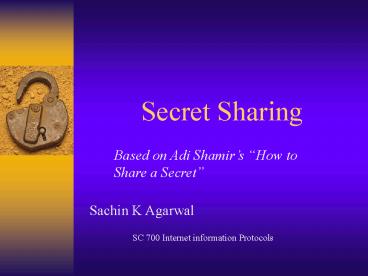Secret Sharing - PowerPoint PPT Presentation
1 / 9
Title:
Secret Sharing
Description:
4 Colonels are to have the code key to arm a nuclear missile. ... So 3 'colonels' get together and decide to blow away AybiL by launching the Nuclear missile. ... – PowerPoint PPT presentation
Number of Views:52
Avg rating:3.0/5.0
Title: Secret Sharing
1
Secret Sharing
Based on Adi Shamirs How to Share a Secret
Sachin K Agarwal
SC 700 Internet information Protocols
2
Inspiration
- 4 Colonels are to have the code key to arm a
nuclear missile. But the Government wants to make
sure that at least any 3 of them agree to launch
before the missile is dispatched. - So the Government wants to break the key code
into 4 pieces so that at least 3 are needed to
put the key code back together. - Generally, assume we want to divide the
information among n people such that at least
k are needed to unlock the information. Such a
scheme is called a (k, n) threshold scheme.
3
How ???
- Consider a polynomial
- P (Z) Ak-1Zk-1 Ak-2Zk-2 Ak-3Zk-3 ... A1Z
A0 - P (Z) is a k-1 degree polynomial with the
constant term A0 - The information D to be distributed is set to A0
- P (Z) is constructed randomly ( which means that
the coefficients Ak-1, Ak-2, Ak-3, , A1 are
selected at random). - P (Z) is then evaluated at n points. We
evaluate P at Z 1,2,3n for example to get
P(1), P(2) P(n). Each one of the keys are
distributed to n people.
4
Example Lets help the Colonels!
- Consider again example where we have 4 colonels
who are to be given a key and at least 3 of them
have to agree in order to unlock the data. Let
the information data be 5. - Here n 4, k 3, A0 5 (Information Data)
- Select P(Z) 9Z2 6Z 5. (Coefficients 9 and 6
are randomly selected). - P(1) 20, P(2) 53, P(3) 104, P(4) 173.
Note that P(0) 5, which is the data itself. - P(1), P(2), P(3) and P(4) are distributed to the
4 colonels. - So now we have set up a (3,4) Threshold Scheme.
5
Putting it Back Again (Decoding)
- So 3 colonels get together and decide to blow
away AybiL by launching the Nuclear missile. - When they start decoding, they have the following
information - They know that they are using a (3, 4) threshold
scheme. - They know their keys. for example lets assume
the 3 colonels know P(1), P(2) and P(4)
respectively. - So the Colonels know that they need to determine
- A0 from some equation of the type
- P(Z) A2Z2 A1Z A0 .
- They Interpolate to determine P(Z)
6
Interpolation ???
- Interpolation is the opposite of Evaluation of P
(Z) at a given point. - In interpolation, we are given some points and
the corresponding values the polynomial P(Z)
calculates to at these points. - We determine the coefficients of P(Z) from this
information, and hence P(Z). - And A0.
7
Colonel Example continued
- P(1) 20, P(2) 53, P(4) 173
- Using a (3, 4) threshold scheme gt k 3.
- So P(Z) A2Z2 A1Z A0
- Solve
- A2 A1 A0 20 (Putting Z 1)
- 4A2 2A1 A0 53 (Putting Z 2)
- 16A2 4A1 A0 173 (Putting Z 4)
- A0 5, A1 6, A2 9
- Information A0 5
8
Issues
- Randomization of the Coefficients while
generating the keys. - P (Z) Ak-1Zk-1 Ak-2Zk-2 Ak-3Zk-3 ... A1Z
A0 - Re using the scheme.
- Choosing a safely large prime field.
9
References
- A. Shamir How to Share a Secret Communications
of the ACM v. 24, n. 11, Nov 1979 - G.R.Blakely, Safeguarding Cryptographic Keys,
proceedings of the National Computer Conference,
1979, American Federation of Information
Processing Societies. - Bruce Schneier Applied Cryptography Wiley
publishers





















![[PDF READ ONLINE] George Washington's Secret Six: The Spy Ring That Saved the American Rev PowerPoint PPT Presentation](https://s3.amazonaws.com/images.powershow.com/10108858.th0.jpg?_=202408250510)
![[PDF READ ONLINE] George Washington's Secret Six: The Spy Ring That Saved the American Rev PowerPoint PPT Presentation](https://s3.amazonaws.com/images.powershow.com/10110263.th0.jpg?_=20240826055)
![[PDF READ ONLINE] George Washington's Secret Six: The Spy Ring That Saved the American Rev PowerPoint PPT Presentation](https://s3.amazonaws.com/images.powershow.com/10107526.th0.jpg?_=202408240910)




![[PDF]❤️DOWNLOAD⚡️ Chef Ricardo's Secret Recipes to Success: From Poverty to Purpose PowerPoint PPT Presentation](https://s3.amazonaws.com/images.powershow.com/10078003.th0.jpg?_=202407140110)
![[PDF]❤️DOWNLOAD⚡️ Chef Ricardo's Secret Recipes to Success: From Poverty to Purpose PowerPoint PPT Presentation](https://s3.amazonaws.com/images.powershow.com/10077818.th0.jpg?_=20240712062)

